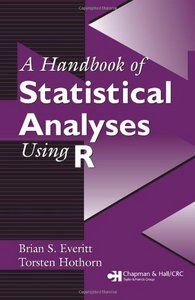
|
FreeComputerBooks.com
Links to Free Computer, Mathematics, Technical Books all over the World
|
|
- Title: A Handbook of Statistical Analyses Using R
- Author(s) Brian S. Everitt, Torsten Hothorn
- Publisher: Chapman and Hall/CRC; 1 edition; eBook (Draft/Open Source Edition by CRAN/r-project.org)
- License(s): GPL-2, GPL-3
- Paperback: 304 pages
- eBook: PDF Files
- Language: English
- ISBN-10: 1584884509
- ISBN-13: 978-1584884507
- Share This:

|
Doing for R what Everitt's other Handbooks have done for S-PLUS, STATA, SPSS, and SAS, A Handbook of Statistical Analyses Using R presents straightforward, self-contained descriptions of how to perform a variety of statistical analyses in the R environment.
From simple inference to recursive partitioning and cluster analysis, eminent experts Everitt and Hothorn lead you methodically through the steps, commands, and interpretation of the results, addressing theory and statistical background only when useful or necessary.
They begin with an introduction to R, discussing the syntax, general operators, and basic data manipulation while summarizing the most important features. Numerous figures highlight R's strong graphical capabilities and exercises at the end of each chapter reinforce the techniques and concepts presented.
All data sets and code used in the book are available as a downloadable package from CRAN, the R online archive.
About the AuthorsN/A
- Statistics
- The R Programming Language
- Programming and Engineering Handbooks
- Data Analysis and Data Mining

- A Handbook of Statistical Analyses Using R (Brian S. Everitt, et al.)
- The Mirror Site (1) - PDF
- The Mirror Site (2) - PDF
-
 Discovering Statistics Using R (Andy Field, et al.)
Discovering Statistics Using R (Andy Field, et al.)
This book takes readers on a journey of statistical discovery using the freeware R, and is written in an irreverent style and follows the same ground breaking structure and pedagogical approach.
-
 Learning Statistics with R (Daniel Navarro)
Learning Statistics with R (Daniel Navarro)
This book takes you on a guided tour of software development with R, from basic types and data structures to advanced topics like closures, recursion, and anonymous functions. No statistical knowledge is required.
-
 Applied Statistics with R (David Dalpiaz)
Applied Statistics with R (David Dalpiaz)
This book provides an integrated treatment of statistical inference techniques in data science using the R Statistical Software. It provides a much-needed, easy-to-follow introduction to statistics and the R programming language.
-
 Statistics with R (Vincent Zoonekynd)
Statistics with R (Vincent Zoonekynd)
Provides an elementary-level introduction to R, targeting both non-statistician scientists in various fields and students of statistics via code examples with liberal commenting of the code and the output, from the computational as well as the statistical viewpoint.
-
 Bootstrap Methods and Applications to R (A. C. Davison, et al.)
Bootstrap Methods and Applications to R (A. C. Davison, et al.)
This book provides a compact introduction to the Bootstrap Method. It is motivated by practical examples and the implementations of the corresponding algorithms are always given directly in R in a comprehensible form.
-
 Modern Statistics with R: Wrangling, Inference and Predicting
Modern Statistics with R: Wrangling, Inference and Predicting
The aim of the book is to introduce you to key parts of the modern statistical toolkit. It teaches you: - Data wrangling - importing, formatting, reshaping, merging, and filtering data in R.
-
 Introduction to Probability and Statistics Using R (G. Jay Kerns)
Introduction to Probability and Statistics Using R (G. Jay Kerns)
This is a textbook for an undergraduate course in probability and statistics, covers various basic and advanced statistical procedures, from correlation and graph creation to analysis of variance, regression, non-parametric tests, and more.
-
 Introduction to Modern Statistics (Mine Çetinkaya-Rundel, et al.)
Introduction to Modern Statistics (Mine Çetinkaya-Rundel, et al.)
This book puts a heavy emphasis on exploratory data analysis and provides a thorough discussion of simulation-based inference using randomization and bootstrapping, followed by a presentation of the related Central Limit Theorem based approaches.
-
 An Introduction to R (Alex Douglas, et al.)
An Introduction to R (Alex Douglas, et al.)
The main aim of this book is to help you climb the initial learning curve and provide you with the basic skills and experience (and confidence!) to enable you to further your experience in using R.
-
 R for Data Science: Visualize, Model, Transform, Tidy, Import
R for Data Science: Visualize, Model, Transform, Tidy, Import
This book teaches you how to do data science with R: You'll learn how to get your data into R, get it into the most useful structure, transform it, visualize it and model it, how data science can help you work with the uncertainty and capture the opportunities.
-
 Regression Models for Data Science in R (Brian Caffo)
Regression Models for Data Science in R (Brian Caffo)
The book gives a rigorous treatment of the elementary concepts of regression models from a practical perspective. The ideal reader for this book will be quantitatively literate and has a basic understanding of statistical concepts and R programming.
-
 Advanced R Solutions (Malte Grosser, et al)
Advanced R Solutions (Malte Grosser, et al)
This book offers solutions to the exercises from Advanced R, 2nd Edition by Hadley Wickham. It is work in progress and under active development. The 2nd edition of Advanced R is in print now and we hope to provide most of the answers.
-
 An Introduction to Statistical Learning: with Applications in R
An Introduction to Statistical Learning: with Applications in R
It provides an accessible overview of the field of statistical learning, an essential toolset for making sense of the vast and complex data sets that have emerged in fields ranging from biology to finance to marketing to astrophysics in the past twenty years.





